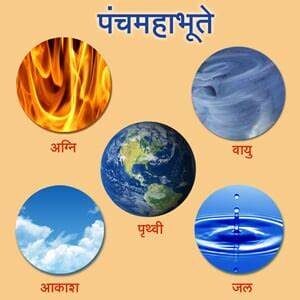Guidelines and basic principles of Ayurveda
Today we are going to learn about the guidelines and basic principles mentioned in Ayurveda.

Guidelines and basic principles of Ayurveda
Panchamahabhuta
Ayurveda is based on the ancient Samkhya philosophy. In it, the entire material world is believed to be formed from five basic principles. Each of these basic principles has its own merits.

Panchamahabhuta Ayurveda
basic principles are as follows –
sky

sky Ayurveda
gas

gas Ayurveda

fire Ayurveda
(water)

(water) Ayurveda
the earth

Ayurveda
Akash
There are many places in the human body for free movement. E.g. The movement of food from the mouth to the stomach takes place through the wind pipe. These voids (Srotas or channels of transport) are a manifestation of Akasa Tattva. They are formed during the development of the child in the mother’s womb. There are channels of transport in various systems of the body, for example, digestive system, respiratory system, circulatory system, lymphatic system cells etc. which can be obtained from the etheric element.
Air
Vayu is the second cosmic principle, motion is the principle. Within the human body, air is present in the large movements of the muscles, the beating of the heart, the expansion and contraction of the lungs, and the movements of the abdominal wall and intestines.
Fire
The third element is Tejas or fire. In the solar system, the source of fire and light is the Sun. In our body, the source of fire is metabolism and it helps in the digestive system. It also manifests as intelligence in our brain cells. Fire also activates the retina which perceives light. In short, body temperature, digestion, thought process and vision are all functions of physical fire.
Water
Ap or water is the fourth important element of the body. It is manifested in the secretion of juices in the digestive system and in the salivary glands, in the mucous membrane and in the plasma and inside the cells of the body. Water is absolutely essential for the functioning of tissues, organs and various bodily systems, and hence it is called the water of life. Svaad Ki Bhavna app is considered by Mahabhuta
Prithvi (earth)
Earth is the fifth and final element of the universe that exists in the microcosm of man. Life on this planet is possible because Earth holds all living and non-living matter on its solid surface. Similarly, in the body, solid structures – bones, cartilage, muscles, tendons, skin, nails and hair – are derived from the earth.
points
Points versus points
Jupiter (Heavy) Laghu (Light)
slow (slow) sharp (severe)
snow, cold (cold) hot (hot)
Greasy (oily, oily) Ruksha (dry)
Shlakshna (Smooth) Khar (Coarse)
Concentrate (thick, thick) Liquid (thin)
soft (soft, tender) hard (strong, firm)
static (sustainable) variable, sir (dynamic)
Micro (very fine) Gross (large)
Vivid (Clean) Pichhil (Bubbly)
Source : Wikipediya
See More
Introduction of Ayurveda-What is Ayurveda?-Ayurveda for Beginners
Faq :
1 How many principles are there in Ayurveda?
2 What are the principles mentioned in Ayurveda?
Web Story – basic principles of Ayurveda